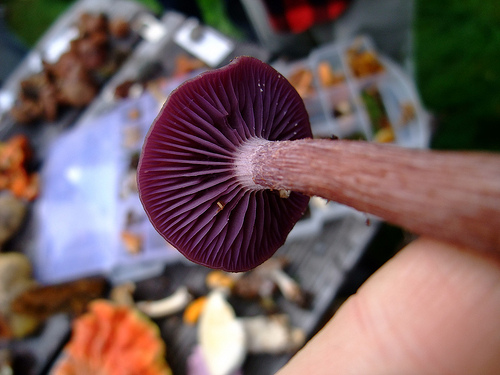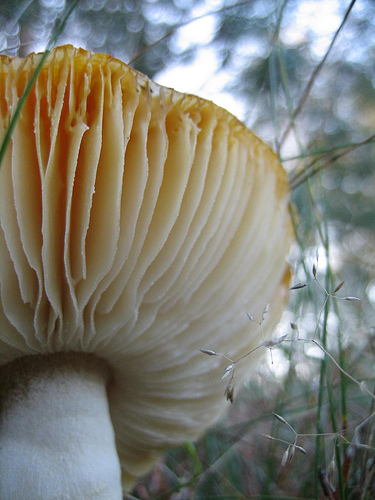Adaptations-
In order for an organism to increase its chances for survival, it must be well adapted to its environment. Adaptations, which are the products of evolution, can be seen in every single organism on the planet! Lets take a look at a few adaptations that P. cubensis has developed.
Like and other species within the Agaricales Order, P. cubensis
bears a gilled underside. As explained earlier, this increases the surface
area exponentially making it possible for one mushroom cap to produce
millions of basidiospores at a time!
 The
gills, themselves, also have their very own adaptation as well. They have
the ability to rotate themselves themselves so that they are always exactly
parallel with gravity. This way, if the mushroom cap were to lean one way or
the other, the gills will still successfully release the basidiospores.
The
gills, themselves, also have their very own adaptation as well. They have
the ability to rotate themselves themselves so that they are always exactly
parallel with gravity. This way, if the mushroom cap were to lean one way or
the other, the gills will still successfully release the basidiospores. Let's pretend, for a moment, that they didn't have this ability. Now,
imagine that you were to tip the mushroom cap to one side. What would happen
to the basidiospores when they are released? They wouldn't break free from
the underside because they would land on an another adjacent gill. But, by
acquiring the ability to rotate the gill angles, P. cubensis is
able to overcome this problem, and it can successfully release it's
basidiospores, which will be carried away by the wind. What an extraordinary
adaptation!
Let's pretend, for a moment, that they didn't have this ability. Now,
imagine that you were to tip the mushroom cap to one side. What would happen
to the basidiospores when they are released? They wouldn't break free from
the underside because they would land on an another adjacent gill. But, by
acquiring the ability to rotate the gill angles, P. cubensis is
able to overcome this problem, and it can successfully release it's
basidiospores, which will be carried away by the wind. What an extraordinary
adaptation!
The entire fungi kingdom also has a unique adaptation, which all of the fungal species within it possess. That adaptation is the ability to secrete exoenzymes, which are responsible for digest organic materials outside of the fungal body. After digestion takes place, the fungus then ingests the material and utilizes it accordingly. Because of this, fungi are able to consume a larger variety of materials compared to most organisms within different kingdoms. Consequently, fungi are more likely to find some form of consumable material in a given environment in comparison to other organisms. This last adaptation bring us to our next topic of discussion: nutrition.